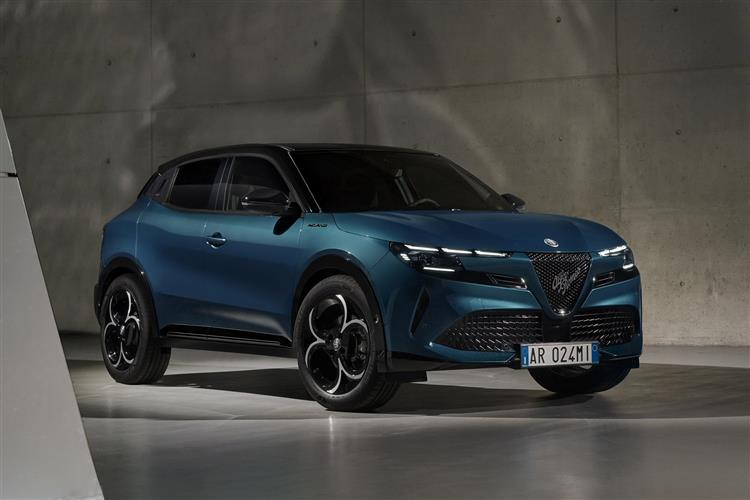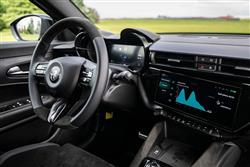RATIONAL NOSTALGIA (some text hidden) --NONE--
By Jonathan Crouch
Alfa Romeo's Junior can also be had in this Ibrida hybrid form. Jonathan Crouch takes a look.
Ten Second Reviewword count: 40
Alfa Romeo's Junior might actually make more sense as a hybrid rather than an EV. Which means you need to try this Ibrida version before settling upon a Junior you can plug in. But what kind of Alfa is it?
Backgroundword count: 227
If you want a small Alfa Romeo and you're a long-time fan of the brand, it is probable that you don't want an EV. In which case, in considering the company's entry-level Junior hatch, you'll pass right over the full-battery Elettrica version your dealer might like to sell you, in favour of the hybrid model we look at here, the Junior Ibrida. At first glance, it's this version that seems to be the proper successor to generations of small Alfa hatches this century, characterised by models like the Giulietta, the 147 and the 146. But all those cars could be had with engines that, at least to some extent, were tuned the Alfa way. The Junior Ibrida, in contrast, gets the same fairly unremarkable 134bhp 1.2-litre three cylinder hybrid engine that currently seems to be fitted to almost everything the Stellantis Group makes. This, you see, was never a combustion-powered small Alfa created in the traditional Alfa way. The Junior Ibrida is there because the brand needs to sell more examples of its Polish-made Junior than the EV market will stand. So there must also be a combustion version in the corner of the showroom for those who don't want an Elettrica. Still, a small frugal hybrid hatch with a sporty vibe might be exactly what number of customers are looking for. Might they like this one?
Engines and Tech Specword count: 301
Though the 1.2-litre 136bhp hybrid engine fitted here is familiar Stellantis Group fare, the car it's installed into should feel considerably more sporting than the other similarly sized models from the conglomerate that use this unit; cars like the Vauxhall Astra, the Peugeot 308, Citroen C4 and the DS 4. Thank the quick steering ratio and the well-judged ride compromise for that. This engine drives the seven-seat Peugeot 5008 along very happily, so doesn't struggle with this premium Italian family hatch, thanks to a useful 230Nm of torque. It's coupled with a clever six-speed dual-clutch e-DSC6 automatic gearbox that incorporates a 28hp electric motor. A 0.9kWh NMC lithium-ion battery powers the self-charging electric system. The petrol engine uses three-cylinders with 1,199cc and works on the Miller cycle, which provides higher thermodynamic efficiency and, therefore, a significant reduction in fuel consumption and CO2 emissions. The engine is also fitted with a special timing chain and a clever variable geometry turbocharger to maximise sustainability and responsiveness at low revs. The hybrid system's permanent magnet synchronous electric motor is integrated into the compact e-DCS6 six-speed dual-clutch transmission and can run on electric power alone at low speeds and under moderate loads. During deceleration, the electric motor acts as a generator to recover kinetic energy and fuel the 0.9kWh battery located under the floor. The system also easily provides power to start the petrol engine. The e-DCS6 gearbox contributes to the comfort and efficiency of this Hybrid model too. Limiting breaks in torque, it gives the feeling of a super smooth ride. The electric motor, inverter and computer are integrated in it to save space and mass. At 8.9 seconds, the zero to 62mph time for this Ibrida is significantly faster than the other comparably-sized Stellantis Group hatches that use it. Maximum speed is 128mph.
To see the full road test text contact us on 0330 0020 227
Pictures (high res disabled)

.jpg)
|
.jpg)
|
.jpg)
| |||
.jpg)
|
.jpg)
|
.jpg)
| |||

|
Statistics (subset of data only)
Min |
Max |
|
Price: |
£27,895.00 (At 14 Feb 2025) |
|
CO2 (g/km): |
117 |
|
Max Speed (mph): |
128 |
|
0-62 mph (s): |
8.9 |
|
Height (mm): |
4173 |
|
Boot Capacity (l): |
415 |
|



